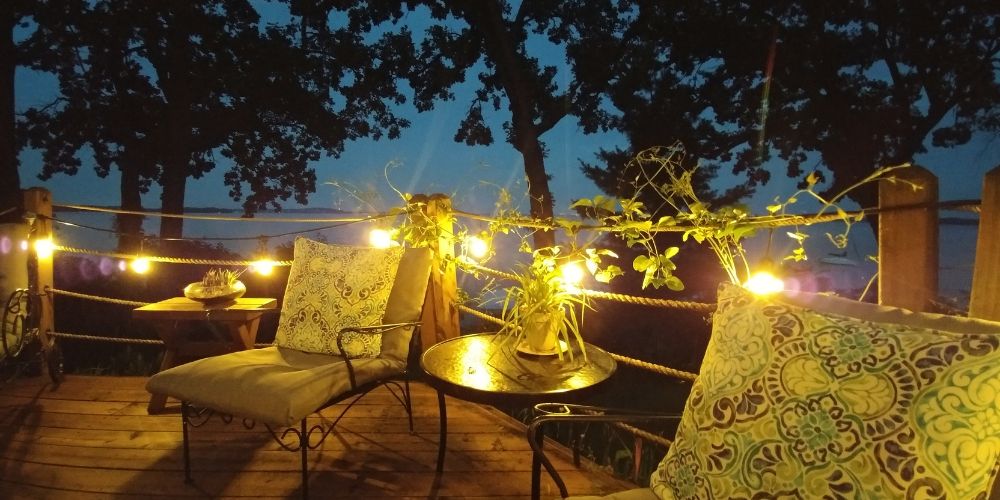A properly illuminated yard serves a purpose beyond simply ‘appearance’ at night. Lights illuminate visitors to the front door, prevent theft, and allow families to use patios after dark. However, conventional fixtures use fixed timers or manual switches, thus remaining on during periods when there is no one outside and wasting additional energy.
Intelligent outdoor lighting systems are the solution to that. They combine contemporary outdoor design and phone apps, sensors, and low-voltage LEDs, providing homeowners and facility managers with unprecedented control over energy, safety, and design.
What Are Smart Lighting Systems? – Key Features

A smart exterior lighting system links each fixture to a central brain—usually a Wi-Fi hub or Bluetooth driver—that talks to a free phone app. The app lets you:
- Set schedules. Pick on/off times for weekdays, weekends, or holidays.
- Use motion or ambient-light sensors. Path lights brighten only when someone walks by or when dusk arrives.
- Dim or color-shift. Some LED lamps change brightness or color temperature to fit events or seasons.
- Monitor energy. Dashboards show real-time watt use, helping cut bills.
Benefits—Safety, Convenience, Energy Savings, Curb Appeal
Here are some of the benefits of smart exterior lighting systems:
- Safety. Automatic lights, which turn on when they detect movement, eliminate dark areas where burglars lurk and ensure that one is not likely to trip on the stairs or the uneven walk. Since the schedule changes with sunset every day, you never drive on a black driveway.
- Convenience. Forget running to the breaker panel during a storm. Open the app, shut off backyard floods, and keep deck lights on for dinner. Vacation mode randomizes patterns so the house looks occupied.
- Energy savings. LEDs already sip power; adding sensors trims usage further. A study by the American Council for an Energy-Efficient Economy found motion-controlled outdoor LEDs can slash exterior electric load by up to 60 percent compared with always-on halogen lamps. Lower run hours also extend lamp life, cutting replacement trips and garden maintenance hours.
- Curb appeal. Right-sized light highlights stone walls, specimen trees, and water features. When every beam points where it should, you avoid glare that washes out night skies. For owners planning resale, tasteful lighting adds perceived value and helps listings stand out in photos. Landscape contractors often place lighting high on the list of quick upgrades that pay off.
Types – Pathway, Accent, Deck/Patio, Floodlights

There are various types of smart exterior lighting systems made specifically for the different parts of your home’s outdoor space:
- Pathway lights. Short bollards or stake lights line walks and driveways. Smart versions often include dusk-to-dawn sensors and step-down dimming late at night.
- Accent or spot fixtures. Narrow beams aimed at sculptures or trees create depth. These fixtures work well with color-tunable LEDs, letting you warm up stone or cool down evergreens.
- Deck and patio luminaires. Surface-mounted puck lights under railings or recessed step lights improve footing without glare. Bluetooth meshes are popular here because the house wall blocks less signal.
- Floodlights. Wide-beam fixtures cover large lawns or parking areas. Smart floods add PIR motion sensors that trigger cameras or alarms. Many homeowners pair them with landscape lighting services to fine-tune angles and avoid light trespass across property lines.
All types can tie into one system, so the app acts as a single dashboard.
Choosing the Right System – Factors and DIY vs. Pro Install
1. Power source
Low-voltage (12-volt) lines are safe for DIY work if you follow the transformer’s load limits. Line-voltage (120-volt) units require a licensed electrician.
2. Connectivity
Wi-Fi offers long range through walls but can crowd a busy network. Bluetooth Low Energy forms a private mesh yet needs repeaters in large yards. Some high-end kits use both.
3. Fixture quality
Die-cast aluminum or marine-grade stainless steel withstands Texas humidity better than thin steel. Look for IP65 or higher ratings for dust and rain protection.
4. Integration
If you already use smart speakers or security cameras, pick lights that work within that ecosystem to cut extra apps.
5. Expansion path
Yards change—new beds, pergolas, or outdoor kitchens. Choose a hub that supports extra nodes so you can add lights without replacing the brain.
DIY or pro? Handy homeowners can handle stake-in path lights and plug-in transformers on small beds. But once you trench across hardscape, tie into house power, or aim uplights at 30-foot oaks, professional exterior lighting installation makes sense. A crew skilled in landscape design calculates beam spread, lumen output, and fixture placement so light falls exactly where needed.
Why Professional Installation Matters
Every yard is unique. Soil types, root zones, and irrigation lines limit where cables can run. LED drivers need dry, vented enclosures; motion sensors must sit at precise heights to avoid false triggers from pets. Tree Amigos Tree Services teams bring years of experience in landscaping and lawn care as well as current training on smart exterior lighting systems. They coordinate with their own arborists to avoid cutting feeder roots during trenching and with irrigation techs so wiring never pinches a sprinkler line.
Their design staff maps glare angles, chooses Kelvin temperatures that suit regional plant palettes, and balances watt loads across multiple transformers. During installation, they label every run, test voltage drop, and program the app while walking you through each screen. Afterward, their residential landscaping services package covers annual checks, lamp cleaning, and firmware updates, keeping the network reliable. Commercial managers can bundle lighting with routine lawn maintenance, saving time on vendor calls.
Additionally, check out this blog: When to Use Waterproof Outdoor Lights
Conclusion – Technology That Pays Off
Smart exterior lighting systems prove that good outdoor design is not just about daylight. By mixing sensors, efficient LEDs, and clear phone controls, these systems cut energy waste, boost safety, and raise curb appeal all at once. The up-front cost quickly returns through lower electric bills and fewer replacement fixtures.
Whether you own a single home or manage several properties, a thoughtful plan guided by the USDA zone map for plantings and a smart lighting layout for night use brings round-the-clock value. For a dependable partner from planning to final inspection, contact Tree Amigos Tree Services. Their certified landscape contractors deliver precise exterior lighting installation, ongoing landscape lighting services, and full-scope landscape maintenance so you enjoy a bright, secure yard year after year.




